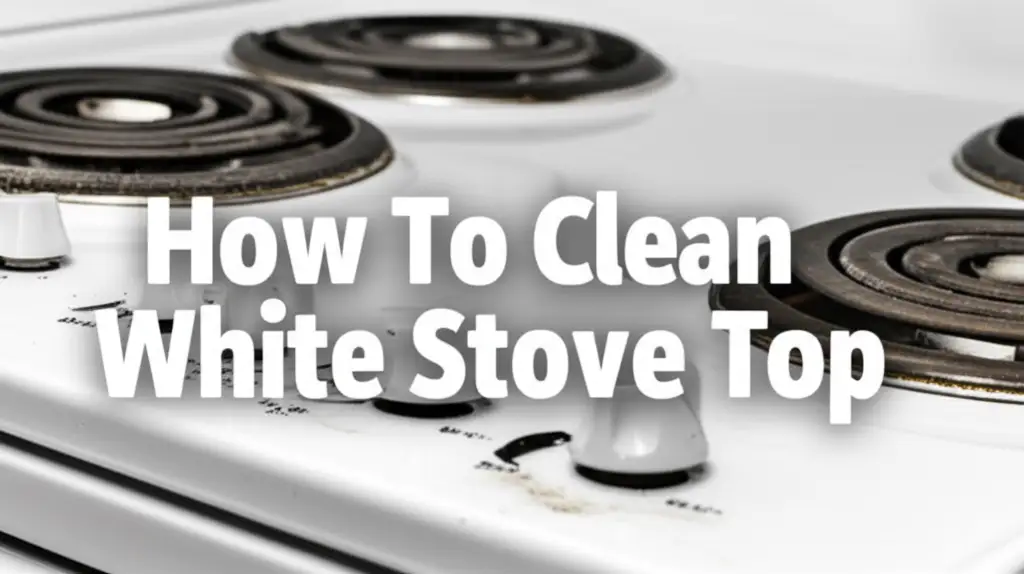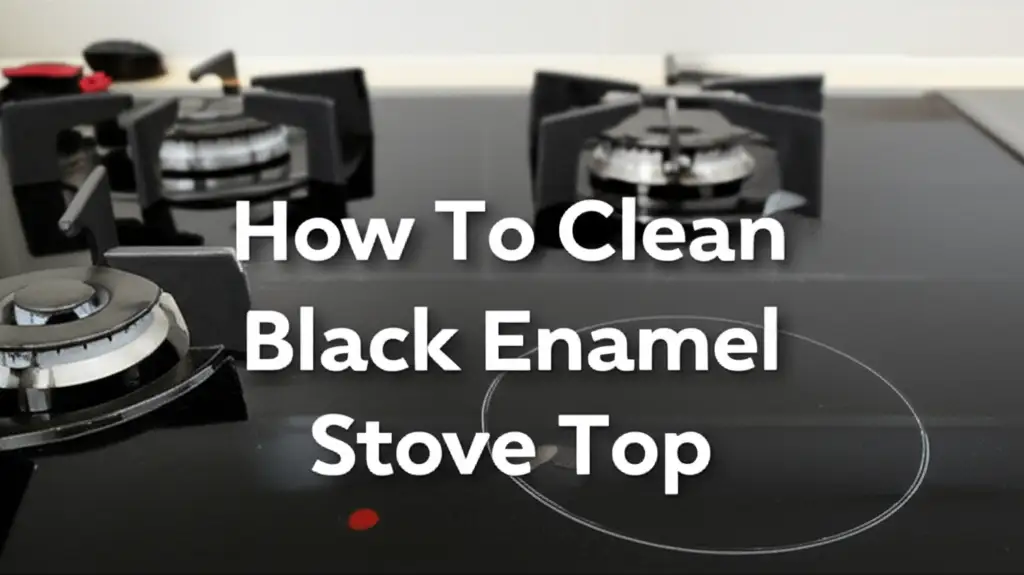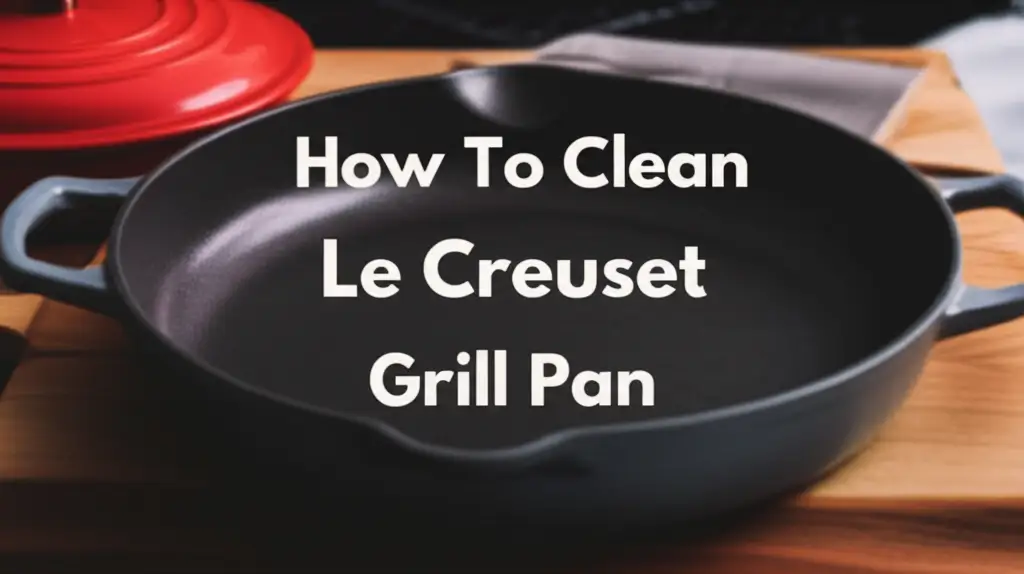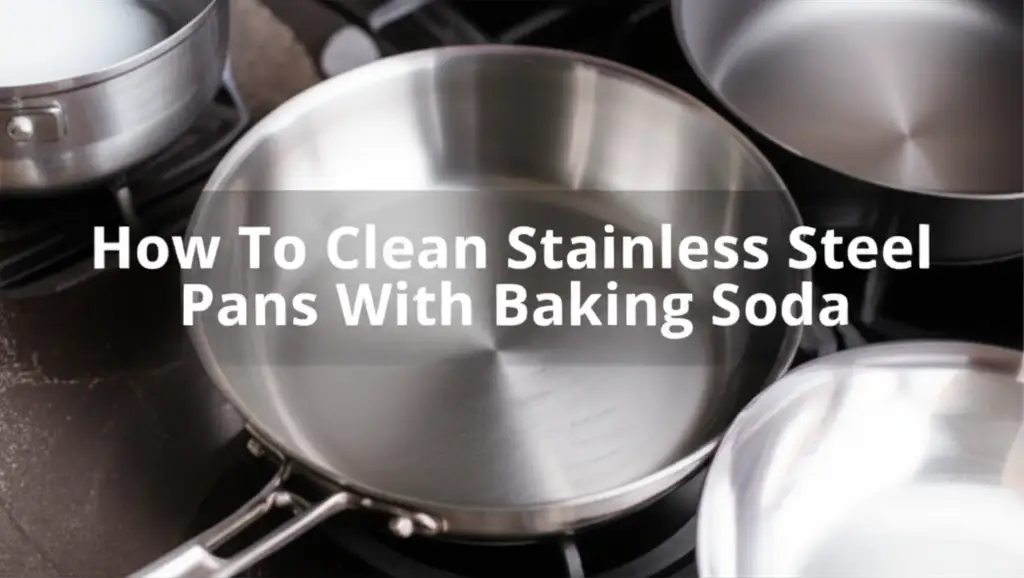· Kitchen Cleaning · 19 min read
How To Clean White Stove Top

How To Clean White Stove Top
A white stove top brightens any kitchen. However, it also shows every spill and splatter. Maintaining its pristine appearance feels like a constant battle. I know the frustration of burnt-on food and grease marks on a beautiful white surface. But keeping your white stove top spotless is simple with the right approach.
This guide shares effective methods to clean your white stove top. We will cover daily cleaning, stain removal, and deep cleaning. You will learn about safe cleaning agents and helpful tools. I will also provide tips to prevent future messes. Get ready to make your stove top shine again.
Takeaway
- Act Fast: Clean spills immediately to stop stains from setting.
- Match Method to Material: Use specific cleaners for enamel, ceramic, or glass white stove tops.
- Gentle First: Start with mild cleaners like dish soap and progress to stronger ones if needed.
- Protect Your Surface: Always use non-abrasive tools and cleaners to avoid scratches.
- Regular Routine: Daily wiping and weekly deep cleaning keep your stove top looking new.
How do I clean a white stove top?
Clean a white stove top by first removing loose debris. Apply a suitable cleaner for your stove top material, such as a baking soda paste for tough stains or a ceramic cleaner for glass tops. Let it sit, then gently scrub with a soft cloth or non-abrasive sponge. Wipe clean and dry completely for a streak-free shine.
Understanding Your White Stove Top Material
White stove tops come in different materials. Each material needs specific care. Knowing your stove top type helps you choose the correct cleaning method. This prevents damage and ensures an effective clean. Let’s look at the most common types.
Enamel White Stove Tops
Enamel stove tops are common, especially on older gas ranges. They have a sturdy metal base with a baked-on enamel coating. This coating gives them their white color. Enamel is durable but can chip or scratch if you use abrasive cleaners or tools. Acids can also dull the finish. I always use gentle products on my enamel surfaces. For instance, if you have a gas stove, you might also be cleaning stove drip pans often. These pans are often enamel.
Ceramic and Glass White Stove Tops
Many modern stoves feature smooth, white ceramic or glass surfaces. These stove tops heat quickly and look sleek. They are easy to wipe clean. However, they are prone to scratching from rough sponges or sugary spills. Burnt-on food requires careful handling. These surfaces offer a beautiful, continuous look. I find that a smooth top stove cleans very differently from an old enamel one.
Coil Electric White Stove Tops
Coil electric stove tops have exposed heating elements. The stove top itself is usually enamel or metal. Food can easily fall onto the surface and bake on around the coils. These require cleaning the drip pans under the coils. The main white surface still needs gentle cleaning. Keeping the areas around the coils clean is important for safety and efficiency.
Identifying your stove top material is the first step. Different materials react differently to cleaners. For instance, what works for a ceramic top may harm an enamel one. Always check your appliance manual if you are unsure. This ensures you use the best approach for your specific stove.
Essential Tools and Cleaning Agents
Gathering the right tools makes cleaning a white stove top easier. Using the correct cleaning agents protects your surface. I always keep these items handy in my kitchen. They help me tackle everyday messes and tough stains. You will find most of these items in your home.
Gentle Cleaning Tools
You need tools that will not scratch your white stove top. Soft cloths are excellent for daily wiping. Microfiber cloths absorb spills well and leave surfaces streak-free. A non-abrasive sponge, like a Scotch-Brite Delicate Duty sponge, is good for light scrubbing. For stubborn spots, a plastic scraper or a razor blade designed for glass cooktops works wonders. Use these with caution and at a shallow angle. These tools protect your stove top’s finish.
Basic Cleaning Agents
Most white stove top cleaning starts with simple kitchen staples. Dish soap is great for cutting grease. Mix a few drops with warm water for general wiping. Baking soda is a natural abrasive and deodorizer. It helps lift tough stains without scratching. White vinegar acts as a disinfectant and cuts through grime. It also leaves a streak-free shine. I use a mix of these for almost every cleaning task. For example, vinegar is very effective for cleaning glass stove tops.
Specialized Cleaners
Sometimes, you need specific products. Ceramic cooktop cleaners are formulated for glass and ceramic surfaces. They often contain mild abrasives that polish without scratching. Bar Keepers Friend is a popular cleaner for stainless steel and porcelain. It can also work on enamel if used carefully. Always test specialized cleaners in a small, hidden area first. This prevents any unwanted reactions.
Safety Precautions
Always ensure your stove top is cool before cleaning. Wear gloves to protect your hands from cleaning agents. Open windows or use a fan for good ventilation, especially when using stronger cleaners. Never mix cleaning products unless specified. This prevents dangerous chemical reactions. Safety comes first when cleaning your kitchen.
Having the right arsenal of tools and cleaners saves you time and effort. It also keeps your white stove top looking new for years. Prepare your cleaning station before you begin. This makes the cleaning process smooth and efficient.
Daily Maintenance for a Spotless White Stove Top
Daily maintenance keeps your white stove top looking its best. It also prevents stains from setting in. This simple routine makes bigger cleaning jobs unnecessary. I find that a quick wipe-down after each use saves a lot of trouble. This is an easy habit to start.
Wipe Down After Every Use
After cooking, let your stove top cool down completely. Then, use a damp microfiber cloth to wipe away any spills or crumbs. A little warm water with a drop of dish soap helps cut light grease. This step takes only a minute or two. It stops fresh food residue from drying and hardening. Dried spills become much harder to remove later.
Address Spills Immediately
Sometimes, spills happen during cooking. If safe to do so, carefully wipe up fresh spills right away. A damp paper towel works well for this. Sugary spills are especially critical on glass or ceramic tops. They can burn onto the surface and cause pitting. Prompt action minimizes the damage. I always keep a damp cloth ready while cooking.
Use Appropriate Protectors
Consider using stove top protectors or liners. These are especially useful for gas ranges. They catch spills and grease before they reach your white surface. You can easily remove and wash them. This saves your stove top from direct contact with messes. For gas stove owners, this can make cleaning your griddle and stove components much simpler. Protecting areas like a griddle on the stove can extend its life.
Light Scrubbing for Minor Marks
If you notice a small, dried spill, a damp non-abrasive sponge can often remove it. Apply gentle pressure. Avoid harsh scrubbing that could damage the finish. A little elbow grease with the right tool goes a long way. This prevents small marks from turning into set-in stains.
Daily maintenance is the backbone of a clean kitchen. It ensures your white stove top remains a bright feature. This simple routine also helps extend the life of your appliance. Make it a part of your post-cooking clean-up.
Tackling Common Stains: Grease, Burnt-On Food, and Spills
White stove tops show every stain. Grease, burnt food, and liquid spills are common culprits. Each type of stain needs a specific cleaning approach. I have found effective ways to tackle these common issues. You can restore your stove top’s pristine look.
Removing Grease Stains
Grease splatters are frequent in any kitchen. For fresh grease, dish soap works wonders. Mix warm water with a few drops of dish soap. Wipe the greasy area with a soft cloth. For dried grease, baking soda creates a powerful paste. Mix baking soda with a little water until it forms a thick paste. Apply it to the greasy spots. Let it sit for 10-15 minutes. Then, gently scrub with a non-abrasive sponge. Wipe clean with a damp cloth. The baking soda helps lift the grease away.
Dealing with Burnt-On Food
Burnt-on food is stubborn. For ceramic or glass stove tops, let the stove cool completely. Apply a generous layer of baking soda paste over the burnt area. Cover the paste with a damp towel for 30 minutes to an hour. The moisture helps soften the burnt residue. Then, use a plastic scraper or a razor blade tool (held at a shallow angle) to gently lift the softened food. Never press too hard. For enamel, a baking soda paste and gentle scrubbing with a non-abrasive pad works well. Trying to clean burnt water off a glass stove top uses similar steps.
Cleaning Spills (Liquid and Sugary)
Liquid spills should be wiped immediately if safe. For dried liquid spills, warm water and dish soap usually suffice. Sugary spills are different, especially on glass/ceramic tops. These can melt onto the surface and cause permanent damage if not handled quickly. Let the stove cool. Then, use a razor blade scraper to carefully scrape off the hardened sugar. Apply a ceramic stove top cleaner afterward to remove any remaining residue and polish the surface.
Preventing Future Stains
Prevention is key. Use splatter guards when frying. Be careful when stirring or pouring. Ensure pots and pans are not overflowing. Wipe up minor splashes right away. These small habits make a big difference. They reduce the amount of time you spend scrubbing later. A clean stove top makes cooking more enjoyable.
Remember to always test any new cleaning agent in an inconspicuous spot. This ensures it does not damage your white stove top’s finish. Patience and the right technique will help you conquer even the toughest stains.
Deep Cleaning Techniques for Stubborn Marks
Sometimes, daily cleaning is not enough. Stubborn marks or old stains need a deeper approach. Deep cleaning revitalizes your white stove top. It removes set-in grime that regular wiping misses. I find these techniques incredibly effective for a truly clean surface.
The Baking Soda and Hydrogen Peroxide Method
This method is powerful for many tough stains on white surfaces. Mix baking soda with a small amount of hydrogen peroxide to form a paste. Apply this paste directly onto the stubborn marks. Let it sit for 30 minutes to several hours, or even overnight for very old stains. The hydrogen peroxide helps break down organic matter and lightens stains. Then, gently scrub with a non-abrasive sponge. Wipe thoroughly with a damp cloth. This can work wonders on yellowed spots or deep grease. This method is also useful for cleaning white ceramic sinks.
Using Ammonia for Baked-On Grime (Caution Advised)
Ammonia can dissolve baked-on grime, but use it with extreme caution. Ensure your kitchen is very well ventilated. Pour a small amount of ammonia into a shallow dish. Place the dish on your (cool) stove top. Cover the entire stove top with a plastic sheet or large garbage bag. This creates a fume tent. Let it sit for several hours or overnight. The ammonia fumes loosen the grime. Remove the cover, open windows, and wipe the softened grime away with a damp cloth. Never mix ammonia with bleach. The fumes are toxic. I only use this method as a last resort.
Razor Blade Scraper for Glass/Ceramic
For glass or ceramic stove tops, a specialized razor blade scraper is a secret weapon. It removes hardened burnt-on food or melted plastic. Hold the blade at a very shallow angle (almost flat against the surface). Gently push forward to lift the debris. Never use the corner of the blade or dig into the surface. This can cause scratches. Follow up with a dedicated ceramic stove top cleaner and a soft cloth to polish the surface. Practice gentle pressure first.
Polishing for a Streak-Free Shine
After deep cleaning, polishing gives your white stove top a perfect finish. For glass/ceramic, use a specific cooktop polish. Apply a small amount and buff with a clean microfiber cloth. For enamel, a light spray of white vinegar followed by wiping with a dry microfiber cloth prevents streaks. A sparkling clean stove top looks fantastic.
Deep cleaning takes more time and effort. However, it significantly improves the appearance of your white stove top. Do this process every few months or as needed. Your kitchen will look fresh and inviting.
Natural Cleaning Solutions for White Stove Tops
Natural cleaning solutions are safe and effective. They are often less harsh than commercial cleaners. Many common household items work wonders on white stove tops. I prefer using natural options when possible. They are gentle on surfaces and good for the environment.
Baking Soda: The Versatile Cleaner
Baking soda is a powerhouse for cleaning white stove tops. Its mild abrasive nature helps scrub away grime without scratching. It also neutralizes odors. For everyday spills, sprinkle baking soda directly onto the spill. Spray with water to make a paste. Let it sit for 10-15 minutes. Then, wipe away with a damp cloth. For tough stains, make a thicker paste with less water or some hydrogen peroxide. This method is incredibly versatile.
White Vinegar: The Shine Enhancer
White vinegar is an excellent degreaser and disinfectant. It also leaves a streak-free shine, especially on glass or ceramic stove tops. After cleaning with baking soda, spray a thin layer of white vinegar over the surface. The vinegar reacts with any leftover baking soda, creating a fizzing action. This helps lift more grime. Wipe dry immediately with a clean microfiber cloth for a sparkling finish. Vinegar is a key ingredient when you clean glass stove tops with vinegar.
Lemon Juice: Fresh Scent and Mild Acid
Lemon juice offers a pleasant scent and mild acidity. It can help cut through light grease and stains. For minor spots, cut a lemon in half. Sprinkle some salt or baking soda onto the lemon half. Use it to scrub the stain directly. The acidity of the lemon helps break down the mess. The salt/baking soda provides gentle abrasion. Wipe clean with a damp cloth. This method leaves your kitchen smelling fresh.
Dish Soap and Hot Water
Sometimes, the simplest solutions are the best. A few drops of grease-cutting dish soap in hot water can clean many white stove top messes. This mixture is excellent for general wiping and fresh spills. The hot water helps loosen grime. The soap breaks down grease. This is my go-to for daily quick clean-ups.
Using natural cleaning solutions provides a powerful clean. They are also cost-effective. They reduce your exposure to harsh chemicals. These methods make cleaning your white stove top a safer and more pleasant task.
Preventative Measures to Keep Your White Stove Top Clean
Prevention is easier than cleaning. Taking a few simple steps can dramatically reduce how often you need to deep clean your white stove top. I believe that good habits are the secret to a consistently clean kitchen. These measures help maintain your stove top’s pristine condition.
Use Splatter Guards
Splatter guards are simple yet effective tools. They fit over your frying pans or pots. These guards stop grease and food particles from splattering onto your white stove top. This prevents many common stains before they even happen. Splatter guards are easy to wash. They save you a lot of scrubbing time. I use them every time I fry or sauté.
Keep Pot Bottoms Clean
The bottom of your pots and pans can transfer grime. Burnt residue on a pot bottom can leave dark rings on your white stove top. Ensure your cookware bottoms are clean before placing them on the stove. This simple check prevents unnecessary marks. It also helps with heat transfer for more efficient cooking.
Wipe Up Spills Immediately
This cannot be stressed enough. Spills dry quickly and become much harder to remove. Keep a damp cloth or paper towel handy while cooking. As soon as a spill occurs, and if it is safe to do so, wipe it up. This is especially true for sugary liquids on glass or ceramic tops. Quick action is your best defense against tough stains.
Use Appropriate Cookware
Ensure your cookware is flat-bottomed, especially for smooth glass or ceramic stove tops. Uneven pot bottoms can scratch the surface. Heavy, cast iron pots can also scratch if dragged. Lift pots instead of sliding them. Use cookware suitable for your stove top material. This protects the surface from damage.
Regular Light Cleaning
Even if no major spills happen, a light daily wipe-down is beneficial. Dust, crumbs, and airborne grease can settle on the surface. A quick wipe with a damp microfiber cloth keeps your stove top looking fresh. This prevents buildup. It keeps your white stove top ready for its next use.
Incorporating these preventative measures into your cooking routine makes a big difference. You will spend less time scrubbing. Your white stove top will stay bright and beautiful with minimal effort. It is a win-win for everyone.
White Stove Top Maintenance for Longevity
Proper maintenance ensures your white stove top lasts longer. It also keeps it performing at its best. Beyond cleaning, specific practices contribute to its durability. I always prioritize these steps to protect my kitchen appliances. A little extra care goes a long way.
Avoid Abrasive Cleaners and Tools
Harsh scrubbing pads or abrasive cleaning powders can scratch white stove tops. This is especially true for enamel and glass-ceramic surfaces. Scratches not only look bad but can also trap dirt. They make cleaning harder in the future. Always opt for soft cloths, non-abrasive sponges, or specialized plastic scrapers. Read labels on cleaning products carefully. This protects the surface finish.
Prevent Scratches and Dents
Be mindful of cookware movement. Avoid dragging heavy pots or pans across the stove top. Lift them instead. Do not drop utensils or heavy items onto the surface. For coil electric stove tops, avoid bending the coils. Any physical damage can compromise the integrity and appearance of your white stove top. Small actions prevent costly repairs or replacements.
Address Yellowing (if applicable to material)
Some white stove top materials, especially older enamel or plastic components, can yellow over time. This happens due to heat exposure or certain cleaning product residues. For enamel, a paste of baking soda and hydrogen peroxide can help lighten yellowing. For other parts, ensure you rinse thoroughly after cleaning. Preventative measures, like avoiding harsh chemicals and regular wiping, help maintain true white.
Check for Burner and Drip Pan Issues
For gas and coil electric stove tops, regular checks on burners and drip pans are crucial. Clean stove drip pans regularly. This prevents grease buildup, which can be a fire hazard. Ensure gas burner caps are clean and clear. On electric coil stoves, keep the coils free of food debris. This ensures even heating and prevents smells. Clean components make the entire stove top look better.
Follow Manufacturer Guidelines
Always consult your stove top’s manufacturer manual. It provides specific care instructions for your model and material. Some manufacturers recommend particular cleaners or methods. Following their advice ensures you maintain your warranty. It also gives you the most effective and safest cleaning practices for your specific appliance.
Implementing these maintenance tips prolongs the life of your white stove top. It keeps it looking new and performing efficiently. Your kitchen will stay bright and functional.
FAQ Section
Q1: What is the best cleaner for a white ceramic stove top?
For white ceramic stove tops, a dedicated ceramic cooktop cleaner works best. These cleaners are formulated to remove burnt-on food and polish the surface without scratching. You can also use a paste of baking soda and a few drops of water or hydrogen peroxide. Always apply with a soft cloth and wipe clean.
Q2: How can I remove burnt-on food from my white enamel stove top?
To remove burnt-on food from a white enamel stove top, let the stove cool. Make a paste using baking soda and a little water. Apply the paste generously over the burnt area. Let it sit for at least 15-30 minutes to soften the residue. Then, gently scrub with a non-abrasive sponge and wipe clean.
Q3: Can I use steel wool on my white stove top?
No, never use steel wool or other abrasive scrubbing pads on any type of white stove top. Steel wool will scratch enamel, ceramic, and glass surfaces. These scratches can be permanent and will trap dirt, making future cleaning harder. Always use soft cloths or non-abrasive sponges.
Q4: My white stove top is yellowing. What can I do?
Yellowing on a white stove top can happen over time. For enamel surfaces, try a paste of baking soda and hydrogen peroxide. Apply and let it sit before scrubbing gently. For other materials, ensure thorough rinsing after cleaning. Persistent yellowing might be normal aging or requires specialized products.
Q5: How often should I deep clean my white stove top?
You should deep clean your white stove top as needed, typically every 1-3 months. Daily light cleaning handles most messes. However, if you notice persistent stains, burnt-on food buildup, or a dull appearance, it is time for a deep clean. Regular deep cleaning keeps your stove top looking its best.
Q6: Are natural cleaners effective on tough white stove top stains?
Yes, natural cleaners can be very effective on tough white stove top stains. Baking soda, often combined with water or hydrogen peroxide, is excellent for scrubbing and lifting burnt-on food and grease. White vinegar is great for dissolving grime and leaving a streak-free shine. These natural options are powerful and safe.
Conclusion
Keeping a white stove top clean is simple. You just need the right knowledge and tools. Regular daily maintenance prevents most stains. For tougher messes, specific cleaning methods work wonders. Remember to identify your stove top material. Use appropriate, non-abrasive cleaners and tools.
From daily wipes to deep cleaning, your white stove top can stay bright. Embrace natural solutions like baking soda and vinegar for effective results. Implement preventative measures to minimize future cleaning tasks. Your kitchen will look fresh and inviting. Make stove top care a regular part of your cleaning routine. Visit beacleaner.com for more cleaning tips.
- white stove cleaning
- stove top care
- kitchen cleaning
- burnt food removal
- grease stains
- enamel stove top
- ceramic stove top




